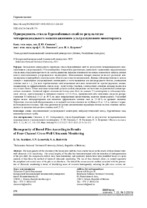| dc.contributor.author | Снежков, Д. Ю. | |
| dc.contributor.author | Леонович, С. Н. | |
| dc.contributor.author | Будревич, Н. А. | |
| dc.coverage.spatial | Минск | ru |
| dc.date.accessioned | 2023-06-19T11:21:42Z | |
| dc.date.available | 2023-06-19T11:21:42Z | |
| dc.date.issued | 2023 | |
| dc.identifier.citation | Снежков, Д. Ю. Однородность ствола буронабивных свай по результатам четырехканального межскважинного ультразвукового мониторинга = Homogeneity of Bored Piles According to Results of Four-Channel Cross-Well Ultrasonic Monitoring / Д. Ю. Снежков, С. Н. Леонович, Н. А. Будревич // Наука и техника. – 2023. – № 3. – С. 216-223. | ru |
| dc.identifier.uri | https://rep.bntu.by/handle/data/129619 | |
| dc.description.abstract | Исследована однородность структуры ствола буронабивных свай по результатам четырехканального межскважинного ультразвукового (УЗ) мониторинга. Определена фактическая длина свай с выявлением дефрагментации ствола сваи, определена прочность на сжатие, выявлены дефекты сплошности на основе совместного анализа данных метода межскважинного ультразвукового мониторинга. Использование четырех каналов позволяет раздельно контролировать периферийную и центральную области сваи в шести направлениях. Данные сейсмоакустического метода совпали с параметрами ультразвукового мониторинга в части выявления зон неоднородности бетона, уменьшения сечения сваи и т. д. Для всех перечисленных свай названными методами испытаний не зарегистрированы данные, указывающие на дефрагментацию ствола сваи – присутствие участков, в поперечных сечениях которых полностью отсутствует бетон. Этими методами испытаний для всех свай подтверждено соответствие их фактической длины проектным значениям. Значимый дефект сплошности бетона сваи 40оп, по данным УЗ мониторинга и сейсмоакустического метода, зарегистрирован в интервале отметок –(17,5–18) м, проявляющий себя снижением скорости распространения УЗ импульса от 25 до 50 % по двум направлениям прозвучивания, включая диаметральное. Указанный дефект можно интерпретировать как снижение эффективного сечения сваи до 25–50 % от среднего значения. Дефектные участки свай обнаруживались в их верхней части на отметках по глубине от 0 до –1,5 м, считая от торцевой поверхности оголовка. При этом различия по физико-механическим параметрам бетона на этих отметках наблюдались и в пределах поперечного сечения свай [1–5]. | ru |
| dc.language.iso | ru | ru |
| dc.publisher | БНТУ | ru |
| dc.title | Однородность ствола буронабивных свай по результатам четырехканального межскважинного ультразвукового мониторинга | ru |
| dc.title.alternative | Homogeneity of Bored Piles According to Results of Four-Channel Cross-Well Ultrasonic Monitoring | ru |
| dc.type | Article | ru |
| dc.identifier.doi | 10.21122/2227-1031-2023-22-3-216-223 | |
| local.description.annotation | The homogeneity of the structure of the boired pile shaft has been studied based on the results of four-channel interwell ultrasonic (US) monitoring. The actual lengthy of the piles has been determined with the detection of defragmentation of the pile shaft, the compressive defects have been determined, and continuity defects have been identified based on a joint analysis of data from the method of interwell ultrasonic monitoring. The use of four channels allows to control separately the peripheral and central areas of the pile in six directions. The data of the seismoacoustic method coincided with the parameters of ultrasonic monitoring in terms of identifying zones of concrete heterogeneity, reducing the pile cross section, etc. For all of the listed piles, data are not registered by the named test methods indicating defragmentation of the pile shaft – the presence of sections in the cross sections of which there is no concrete at all. These test methods for all piles confirmed the compliance of their actual length with the design values. A significant defect in the continuity of the concrete of the 40op pile, according to the data of ultrasonic monitoring and seismoacoustic method, was registered in the interval of marks – (17.5–18) m, manifesting itself a sa decrease in the propagation velocity of the ultrasonic pulse from 25 to 50 % in two sounding directions, including diametrical. This defect can be interpreted as a decrease in the effective section of the pile to 25–50 % of the average value. Defective sections of piles were found in their upper part at depth marks from 0 to –1.5 m, counting from the end surface of the head. At the same time, differences in the physical and mechanical parameters of concrete at these marks were also observed within the cross section of piles [1–5]. | ru |

